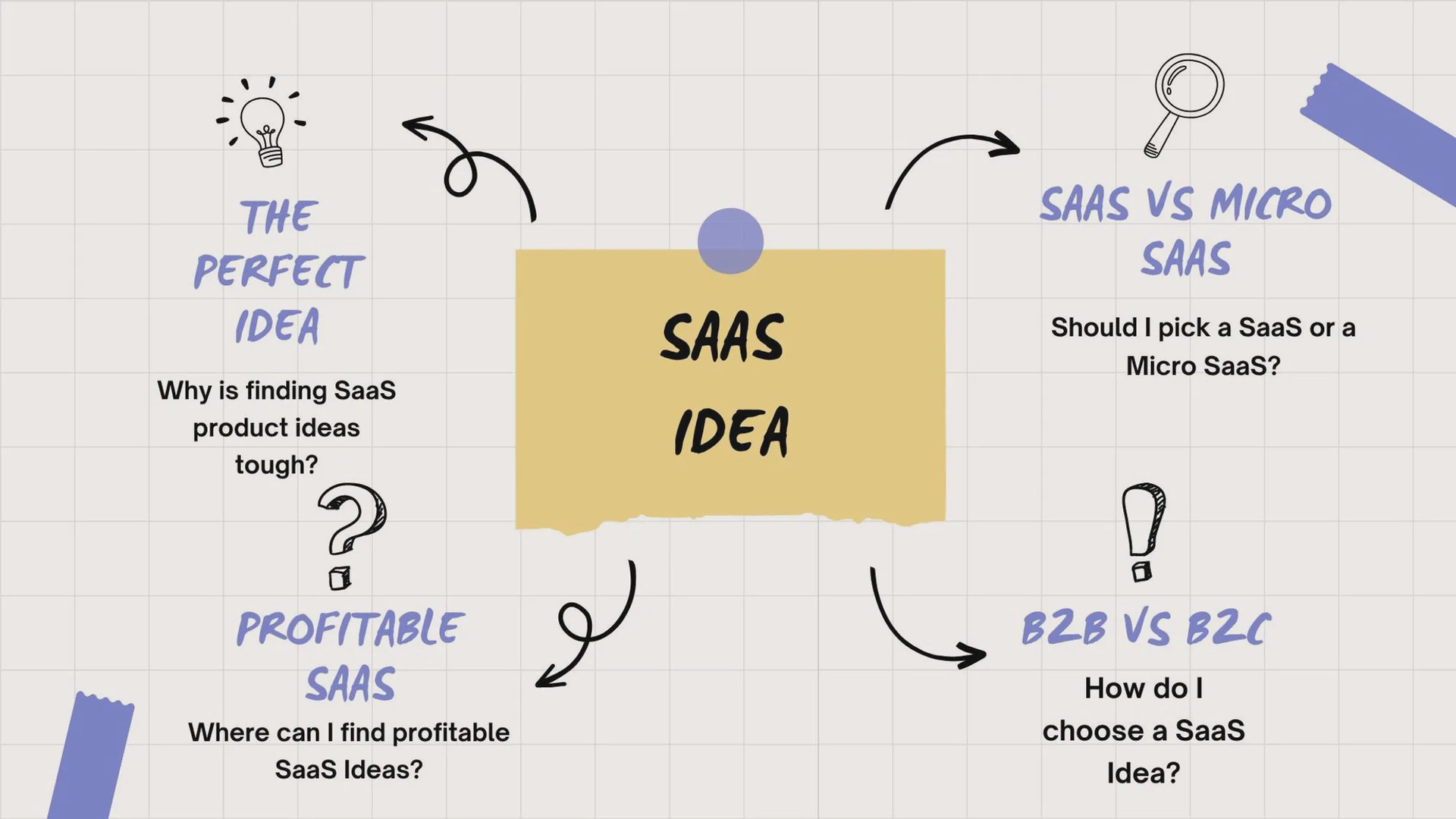
Top 10 B2B SaaS Examples - Innovative Software Solutions for 2024
Ten B2B SaaS examples that I'm sure you're going to get some amazing inspiration from. For each of these …

You want to create a SaaS and all you need is a great idea. Obviously you also need a sales team, customer support team, marketing team, operations and business development, security and legal. And wait a minute, what if I don’t want to manage any of this?
Can you still build a SaaS?
Just you? Absolutely.
These people are called indie creators and they build so called microsass. They do everything themselves, and their team consists of one single person, the founder itself.
In this article, I’ll give you 5 SaaS ideas that you can build as a solo founder, including examples from the real world.
The first building a tool on top of ChatGPT AI is all over the place right now. It’s the most trending topic of 2023, and it’s an obvious opportunity to build a small tool that that extend the functionality of ChatGPT itself. Check this out.
Gatsby has created a version of ChatGPT that features a much nicer UI, the ability to organize your chats in projects and folders, and a library of AI characters ready to use. They also have a chrome extension and a lot of other things. Super cool.
A tool similar to this is typing mind, which also features a whole lot of extensions to the regular ChatGPT interface. And here’s the interesting part. Both of these tools require you to bring your own API key from OpenAI.
So they’re not paying for the AI usage. They simply offer a much more convenient and feature rich interface for their users. And I know what you’re thinking.
Why would people pay for this if they still have to pay for their own AI usage through OpenAI? Well, as it turns out, people are happy to both GatsbyAI and Typingmind sell as lifetime deals. And Tony, the creator of Typingmind, already made tens of thousands of dollars on this tool, and it’s literally only a few months old. When you pay OpenAI per token through their API, it’s actually quite cheap.
So unless you’re using AI a lot, probably you won’t ever spend $20 per month, which is the current price of ChatGPT. So for most users, there’s actually money to be saved here, and you get a much more feature rich interface. So there’s your idea.
Bring your own chat GPT like interface to market and give it your specific twist. And this idea is no code friendly. You can totally build an interface like this in a no code tool like webflow or bubble and then consume ChatGPT’s API directly from the client.
I think there’s still plenty of room in this market and a lot of money to be made. So I just got rid of my entire team. No people on a payroll, no leading and managing anyone.
I have close to zero responsibilities now, and my startup is way less risky for me to run. But when I gave up one type of risk, I’m now dealing with something else.
Of course I’m referring to platform risk. The most realistic way to get a product to market as a solo founder is to build on top of existing tools and technologies. But we have to face it, the trade off from building these kinds of products is that we’re gonna be dependent on other platforms that comes with risk.
When we’re building on top of chat GPT, there’s a legitimate chance that OpenAI will roll a similar feature themselves, which might render your service useless. In fact, in one of my previous videos, I’m showing you how to validate a SaaS idea. And the idea used in this video was an AI prompt designer.
And there you go. This is now a plugin directly available from ChatGPT. The good news is that if that happens, we’re just gonna build something new.
We’re a one man team. It’s much easier to just go with the flow.
Notion is an incredible tool.
Users all around the world love using it for note taking, sharing information, project management, and everything in between. In fact, notion has become so popular that people started building third party tools on top of notion, and some of them really add a tremendous amount of value on top of an already amazing tool. You can use notion forms to create forms in notion.
You can use Queue to schedule tweets from notion. You can use feather to publish blog posts from notion.
All of these tools are thriving, profitable SaaS tools, and they’re built by indie creators consisting of one or two person teams. There are a ton of opportunities here.
But there was one thing that turned out to be disappointingly unsupported by notion itself, automation, which for us resulted in this a lot of cloud functions with custom code that uses notion’s API to do automation. And I actually know quite a lot of other teams who end up with this huge spaghetti of sad and make in order to turn notion into something highly operational. So here’s the opportunity.
Create an automation hub specifically for notion, design it to look and feel similar to Zapier, or make and offer a lot of ready made integration plugins that can be composed to create custom automation workflows for notion. I’ve been looking for this tool myself.
Of course, building notion tools comes with exactly the same level of risks as we discussed before. Recently notion added both AI and their new projects, so perhaps we can expect them to also add automation. Who knows, some of us were expecting this already a year ago and nothing really happened so far.
I think building a tool that hooks up notion with various other tools is a great microsass opportunity.
Let me just give you a quick backstory. We’re currently building Linkdrip, a no code link engagement tool.
As a part of this tool, a user can add their own custom domains to use as a proxy for the links you create with Linkdrip. And this part was painful to deal with. Even I as an experienced software engineer was struggling to get this working smoothly.
Fortunately, I’m in a close discord group with some really smart people. One of them is Oliver jumpers who’s a content creator in the tech space and a very experienced software engineer. He helped me get this servers up and running and I was begging him to make this into a SaaS.
But since he didn’t want to jump on this one, I’m now bringing it to you as service that can handle custom domains and SSL certificates, allowing other SaaS tools to offer white label and multi tenant features without having to deal with the technicalities. It’s pretty niche, but I really think there’s a need here and if you’re a really hardcore software engineer, I don’t see why you wouldn’t be able to run a service like this as a solo founder. So in no way is this one no code friendly.
Let’s move on to something less technical and more oriented about learning. Here’s the an interactive learning platform for a specific niche there are already a lot of platforms out there that offer courses.
Some of them have quizzes and some have assignments that you can download. Though countless studies have shown that we learn much more effectively by performing an action rather than simply reading or hearing someone explain something. So this idea is to use technology to provide learning material in a highly interactive and gamified way for a specific field of work.
A great example of this is iCodeThis by Florin pop. If you want to learn web development, you can sign up for iCodeThis and you will get a daily coding challenge that you need to solve. You solve the challenge directly inside the tool itself and once you’re done, you can see how other people solve their challenge.
You can feature this work on your own profile such as LinkedIn, and if you upgrade, you get access to learning paths and mentoring by professionals in a closed discord group. I think there’s a ton of potential in this space. You can make interactive learning platforms for marketing, copywriting, legal data, science, really any crap that takes place digitally.
And if your tool becomes highly reputable, you can even consider issuing certificates that verify a certain level of knowledge and skills. And again, this is not building on top of any existing tool, and your competitive advantage in a tool like this becomes your expertise and your ability to create interactive learning content rather than solving something highly technical.
Alright, the last idea, and probably my favorite idea of all of these, is just on the border of what I would consider Microsaas. But it solves a huge problem, a low code integration platform. So here’s the problem. Every time we as developers need to integrate other services, we need to integrate the whole thing from scratch.
If I want to have Facebook scheduling as a part of my service, I’ll have to build the integration from scratch. If I want to support Slack, I’ll have to build it from scratch. If I want to use any service that offers an API, I would have to build it from scratch and so is everyone else.
So you could build a low code solution that lets you integrate with various APIs on the Internet in a simple and standardized way. There are tools like Firebase and Superbase that solve this for authentication and databases. There are tools like stripe that solve this for payments and subscriptions.
We need a tool that can connect all kinds of third party services through an elegant, standardized low code solution. We have tools like Zapier make and if this, then that solves this for no code. But these tools are not always ideal when we’re building our own products.
A low code solution, including a single JavaScript SDK I can use to integrate other services easily would be a killer product. And yes, we are back to building on top of other tools here. However, we do this in a much more diversified way since the idea is to offer easy to connect integrations with a whole bunch of different tools.
From a platform risk perspective, we are in a much better place here than if we build on top of a single tool like notion or ChatGPT. Whether a tool like this can be built entirely by a single person, perhaps, though I admit that this one is on the border. On the other hand, if you can pull this one off, you’re sitting on a super powerful product.
So if you’re considering building any of these ideas, please let me know in the comments. I’m very interested in hearing more about it.
Also, I get this question a lot, so I want to make something clearer.

Ten B2B SaaS examples that I'm sure you're going to get some amazing inspiration from. For each of these …

Top 13 Micro SaaS Ideas - Profitable Examples for 2024. That's going to give you some really good inspiration …

Every year, there are new technologies that make a difference in the world. 2024 is turning out to be amazing …